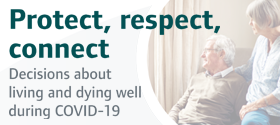Key points
- Advance care planning, end of life care and DNACPR decisions were often not sufficiently high on the agenda at a system level, and leaders lacked oversight of DNACPR decisions.
- Providers and commissioners could not always demonstrate how they were assured of the quality of DNACPR decisions.
- While we found evidence of learning from incidents at local provider level, there was minimal evidence of learning being shared across areas. A lack of evaluation and oversight also meant that it was difficult to say how effective any learning from incidents had been in improving people’s experiences.
- Leaders of providers and clinical commissioning groups told us that clinicians, professionals and workers knew how to challenge DNACPR decisions but had never been challenged themselves or had records of complaints and concerns.
During the COVID-19 pandemic, all health and social care leaders and system leaders had to make crucial operational changes in the face of pressures never experienced before.
In a bid to be effective and responsive to people’s needs, we found that these leaders worked together collaboratively and proactively throughout the pandemic.
We saw, for example, improved communication and support for integrated working between adult social care and primary medical services. We found examples of GP services working more closely with adult social care services to raise awareness of enhanced care models. (The Enhanced Health in Care Homes model moves away from traditional reactive models of care delivery, towards proactive care that is centred on the needs of individual residents, their families and care home workers. Such care can only be achieved through a whole-system, collaborative approach.) This led to a more personalised approach for some people, with the right multidisciplinary team involved.
While there had been less focus by clinical commissioning groups (CCGs) on advance care planning, end of life care and DNACPR decisions at the start of the pandemic, they did give more attention to preventing blanket and inappropriate DNACPR decisions latterly following concerns raised by national organisations and the media.
Commissioners had played a role in the collating and dissemination of guidance and information, but there were some concerns around the reach of this and how well it was understood. It was acknowledged that there had been lots of guidance, but much of this was conflicting or confusing and DNACPR decisions hadn’t been given a high priority.
Some frontline staff we spoke with in one area, particularly those working in adult social care, felt that leaders were not visible enough, leaving them feeling isolated.
Oversight and assurance of DNACPR decisions
The majority of people we spoke with told us that they weren’t doing anything differently for DNACPR decisions during the pandemic and that they were following existing processes and protocols.
While every area was keen to express the importance of person-centred care, oversight of DNACPR decisions varied between and within the different areas we looked at. Without strong auditing processes in place, they could not be sure that decisions were always appropriate and that people’s rights and interests were being respected.
Lack of a consistent approach also meant that reviews were potentially being missed or not done in an appropriate manner. We found that, on occasion, inappropriately placed DNACPR decisions were only found during audits or when documentation was reviewed when patients moved to different services.
There had been some action taken to rectify some shortfalls locally and acknowledgement from some systems where developments were needed. However, work is needed to develop a long-term solution so that systems can assure themselves that poor practice is addressed and eradicated, and better outcomes for people are assured.
Sharing learning from incidents
Where learning was being shared across a local area, it showed positive leadership, engagement and collaboration to upskill clinicians, professionals and workers, learn lessons as a system to prevent inappropriate use of DNACPR decisions, and promote better outcomes for people. For example, one trust we spoke with told us that they had commissioned a review to look at all deaths during COVID-19. They shared the learning from this review with the clinical commissioning group and other health and social care providers in the local area. As a result, improvements were made to how care was commissioned and more integrated models of care were put in place across the area to promote a consistent approach.
Leaders in providers told us that clinicians, professionals and workers knew how to challenge, but these leaders had never been challenged themselves or had records of complaints and concerns from the public. They also generally believed that, if frontline staff had concerns, they would feel able to raise them via the right channels. However, as we highlight in the training section of this report, we had concerns that clinicians, professionals and workers did not feel able to raise concerns.
Next page
System response to the pandemic and DNACPR decisions
